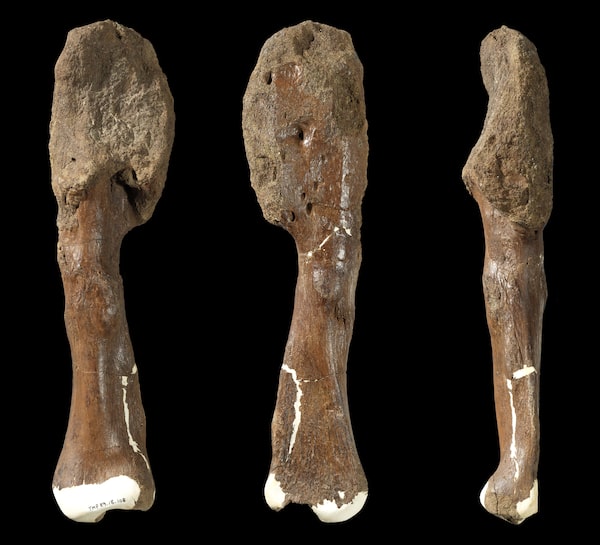
Part of the fibula of a centrosaur, a type of horned dinosaur that was discovered in southern Alberta, is shown from three different angles. The irregular growth at the top of the bone has been identified as a fossilized osteosarcoma, the first confirmed case of cancer in a dinosaur.Handout
The diagnosis has been about 76 million years in the making, but Canadian researchers say they have identified the first confirmed case of cancer in a dinosaur.
The evidence comes from a broken fibula – a leg bone that once supported a centrosaur, a two-tonne plant eater, as it grazed near the shores of a long-vanished sea in prehistoric Alberta.
The 30-centimetre-long bone fragment is all that remains of the beast, but an irregular growth at one end has led a team of experts to conclude that the dinosaur was riddled with cancer when it died, together with the rest of its herd, likely during a natural disaster.
The team’s findings, published Monday in the medical journal The Lancet Oncology, support the view that the most common form of bone cancer in humans – osteosarcoma – has a lineage that reaches back long before our own species walked the Earth.
“All vertebrates share a similar anatomy,” said Seper Ekhtiari, an orthopedic surgery resident at McMaster University in Hamilton and the lead author of the study.

This illustration shows where the bone would have been located in the skeleton.Handout
He added that, at the cellular level, vertebrate bones have not changed much since they first evolved. In theory, then, it should not be a surprise to see a dinosaur bone bearing evidence of a disease that is present in humans today. But in practice, the odds of finding such a bone are incredibly small.
“It’s like a needle in a haystack,” said David Evans, a team member and senior curator of vertebrate paleontology at the Royal Ontario Museum in Toronto. “You need the cancer to have progressed to the point where it manifests on the bone, and then you need the bone to have been preserved.”
The fortuitous discovery was made more likely because of Darren Tanke, a senior technician at the Royal Tyrrell Museum in Drumheller, Alta., and a practised expert in paleopathology, the science of fossil injury and disease.
For years he has been setting aside dinosaur bones in the museum’s collection that appear to be unusual in some way. It was this prescreened set of oddballs that Dr. Evans and colleagues came to sift through in March, 2017, hoping to turn up something interesting. Among the collection was the broken centrosaur fibula, which has a smooth, brownish surface that gives way to a rough, knobby clump at one end, making the bone look like a misshapen club.
At first glance, Dr. Evans said, the feature could be mistaken for a fracture callus – a bulge that surrounds and joins the ends of a broken bone as it heals naturally. On closer inspection, however, it had the wrong shape to be a callus, and the researchers immediately suspected a tumour.
What followed was a detailed examination that included CT scans and thin sectioning of the fossil to see if the cause of the growth could be determined. The team also compared the bone with a normal centrosaur fibula and with a human fibula with osteosarcoma to arrive at the diagnosis.
The sections and scans revealed that cancer was reaching down through the bone fragment specimen and erupting in other places – a sign that the disease was likely widespread throughout the animal, the team suggested in its report.
The damaged bone would have made the centrosaur vulnerable and perhaps less likely to escape a severe coastal flood that occurred some time between 75.5 and 77 million years ago in what is now Dinosaur Provincial Park. It’s this event which probably led the cancerous fibula to wind up in a bone bed full of other centrosaur remains.
“This animal probably would have been quite lame and certainly weak and in a lot of pain at the time that it died,” Dr. Evans said.
Bruce Rothschild, an expert in skeletal pathology at the Carnegie Museum of Natural History in Pittsburgh, who was not involved in the Canadian find, said the team’s diagnosis of osteosarcoma was “likely,” but that a non-cancerous bone infection called osteomyelitis could not be completely ruled out based on the available evidence.
In their report, the team wrote that other features that would be expected with osteomyelitis were not present in the bone, and Dr. Ekhtiari added that while osteomyelitis destroys normal bone, “it does not cause the formation of new, disorganized bone” like that seen in the centrosaur fossil.
Dr. Rothschild has been involved in studies of bone cancer in other fossils, including that of a 240-million-year-old turtle specimen with osteosarcoma published last year. He said that such discoveries offer the potential to reveal changes in the prevalence of certain diseases across geological time, along with “the intellectual stimulation of playing Sherlock Holmes.”
Dr. Ekhtiari, who spends his days in the operating room working on human bones, said that when he was growing up his aspirations would alternate between two dream jobs: being a medical doctor and working with dinosaur fossils.
“I never imagined that one day I would get to do both,” he said.
Our Morning Update and Evening Update newsletters are written by Globe editors, giving you a concise summary of the day’s most important headlines. Sign up today.
 Ivan Semeniuk
Ivan Semeniuk